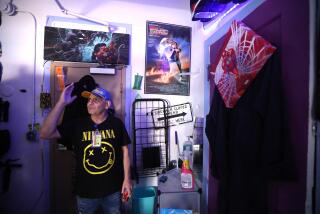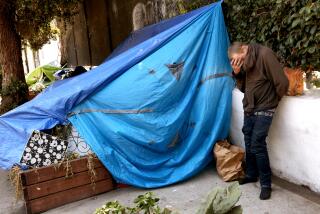Civic League Finds New Life in Aftermath of Condo Dispute
Last fall, a controversy over construction of a condominium on Sunset Boulevard brought the Pacific Palisades Civic League into the limelight for the first time in years.
Neighbors opposed to the condo accused the low-profile league of refusing to exercise its legal authority over the outward appearance of buildings in Tract 9300, which consists of 4,000 lots that cover most of the Palisades. They criticized the leagueâs domination by real estate agents and architects.
The 71-foot-high condominium stands nearly complete now, its beige exterior trimmed in blue.
But the buildingâs impact on the Civic League will last long after the condoâs 18 units are occupied.
Expanded Membership
In the aftermath of the condo controversy, the Civic Leagueâs dues-paying membership has grown from 100 to 230, according to Secretary-Treasurer Catherine Sanders. Early this year, the board increased from 12 to 19, including two members of the Mid-Sunset Residents Assn, a newly formed organization of neighbors of the condo.
Specific guidelines are being drawn up for the league to follow in considering project proposals. Steps are being taken to ensure that nearby residents are notified of projects coming before the league.
And two weeks ago, in the first contested league election in memory, the Mid-Sunset group succeeded in ousting four board members, replacing them with a slate pledged to a more aggressive stance toward developers planning to build in the leagueâs jurisdiction.
Among those deposed was league President Doug Uhler, a real estate agent who was accused of conflict of interest for helping the condominium developer, Alex Furlotti, find storage space for construction materials. Uhler denied a conflict--both he and Furlotti said no pay was involved--but abstained from votes on the project after the allegations were aired.
Architect Heinz Meier, chairman of a league committee charged with making recommendations on builder proposals, also lost his place on the board.
Uhler and Meier both had been nominated by the board to retain their positions.
âA lot of people in the Palisades had given up on the Civic League,â said Gary Nash, president of the Mid-Sunset organization. âWe think we have brought the league back into the common philosophy of other active groups in the Palisades, and that is the protection of the character of the Palisades and preventing commercial development from overwhelming the area.â
âIt was felt that the league was oriented toward developers, excessively so,â said Ronald Dean, one of the new board members elected on the Mid-Sunset slate. âThis was meant as a signal of change.â Dean also is president of the Pacific Palisades Residents Assn., a homeownersâ group representing about 1,700 families.
The new makeup of the board is not universally popular, however. Two reelected board members, Ernest Buchholz and Edna Oleson, have resigned.
Action âUnfairâ
âThe people who have worked very hard, to just dump them I donât think was fair,â Oleson said.
The Civic League has potentially stronger powers than any of the numerous other homeownersâ groups in the Palisades, where residents boast that their efforts have maintained a distinct village atmosphere in their cliffside community, even though it is part of the sprawling city of Los Angeles.
The league was established in 1943, as successor to the Palisades Assn., a realty company formed in 1920 by the communityâs Methodist founders. The league took on the disbanding associationâs responsibility to oversee âoutward appearance and design.â
The deeds in Tract 9300 forbid owners to build or remodel structures on their lots without the leagueâs written approval. Violatorsâ property can be seized by the league.
By last year, though, many residents of the tract had little or no knowledge of the league. Board members recruited new members from among their acquaintances, and it was difficult to fill slots.
No Time or Money
The private group met once a month at the local library to review applications, usually without an audience. There was no time, money or manpower to search out those who did not comply with the deed restrictions.
âThe issues were more or less reviewing garage additions,â said R. B. Wilken, a re-elected board member who is the new league president.
When Furlotti decided to build a condominium on the north side of Sunset, near Muskingum Avenue, the neighbors on the ridge above were angry. They said the building would block their ocean views and invade their privacy.
They became aware of the deed restrictions that grant the league the right to decide whether to permit certain designs to be built. The league had approved preliminary plans for the condo.
The neighbors said they had no grounds to contest the approval until Furlotti erected a wooden frame that left no doubt that the building would be three feet higher than shown on his plans--enough, they say, to blot out the last sliver of ocean blue visible from their back windows and patios.
Upset With League
They became upset when the league did not take steps to force Furlotti to build only what was authorized. (The developer contended that the leagueâs authority over design did not extend to building heights).
The neighbors formed the Mid-Sunset group and, during a packed meeting, successfully pressured the league to lend its name to their cause in court.
The dispute, though, was settled out of court. Furlotti continued his work on the condo but provided money for landscaping that the neighbors could use to shield their homes from his project.
Representatives of the Mid-Sunset group said construction had proceeded so far that they thought the leagueâs powers would be better tested in another case.
But onlookers in other Palisades neighborhoods revived memories of past grumblings about the league.
Pulling the Plugâ
âThe Furlotti thing was kind of like pulling the plug,â Dean said. âIt made it apparent that the Civic League could be more active and effective.â
Wilken, the new president, said the controversy âmade people realize thereâs a whole bunch of property here zoned for multi-residential and thereâs a potential for more of this. They realized the Civic League is the only protection other than city planning, which at this point is not acceptable to many of the neighbors.â
Uhler acknowledged the league had some shortcomings.
âThe league has allowed things to happen in years past that they should have done something about,â he said. âThey have passed on doing some things they should have done.â
As for the Furlotti project, board members âprobably werenât as thoughtful in that process as they could have been,â he said.
âBut thatâs hindsight,â Uhler added.
New Guidelines
After the condo incident, he said, the league board began drawing up guidelines to bolster its legal position in the future and adopted an interim height rule based on a proposal by 11th District City Councilman Marvin Braude. The rule would establish a buffer zone between apartment or condominium buildings and single-family neighborhoods, allowing condo heights to increase as distance from the family homes increases.
âThere was no reason for anyone to think we wouldnât be enforcing these rules on other projects,â Uhler said.
Said Dean: âI hope Doug wasnât taking this personally. The change was more symbolic. As president, perhaps he became a symbol of the old Civic League.â
Uhler and Meier said they wish the new Civic League well. But both expressed the hope that the board will not concentrate solely on reducing the scale of multi-family dwellings and commercial structures.
âWhat I just hope is that size and traffic isnât going to take over so much (as a concern) that architectural quality as a whole suffers,â Meier said. âTen years from now, the Palisades will be two-story. There are dozens, hundreds of remodeling projects going on. That needs to be regulated too and that takes a lot of time.â
More to Read
Sign up for Essential California
The most important California stories and recommendations in your inbox every morning.
You may occasionally receive promotional content from the Los Angeles Times.






